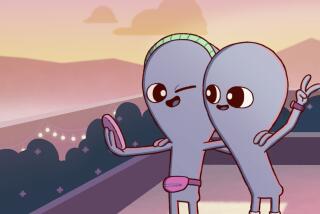PBS Rattles the Planet
- Share via
One of the best things about PBS’ thoughtful new series, “Race to Save the Planet,” is that it doesn’t try to sugarcoat the bad news. And just describing the global environment means plenty of bad news.
The 10-part series is hosted by Meryl Streep and narrated by Roy Scheider.
“Race to Save the Planet” shows the state of the world’s environment and the interconnection of the problems that threaten it. The series is an antidote to despair. It’s sad and scary, but it’s neither shrill nor naive.
“We thought it was time for a series to attempt to show that there is a way forward,” said executive producer John Angier, a co-founding producer of PBS’ distinguished science series “Nova” in 1975.
“The television audience and the magazine-reading public have probably had quite enough of doom and gloom and there were other stories to tell,” he said. “The structure of the series is such that it kind of goes from the bad news to the good news.”
And a lot of bad news there is. Humanity, the series notes, has been adversely affecting its environment since the Neolithic Revolution, when we changed as a species from hunter-gatherers to farmer-herders.
Our first experiments with agriculture were dismal flops, exhausting the land with overcultivation, overgrazing and deforestation. The Neolithic Revolution’s basic lesson was that desert can always return. And may yet.
A few thousand years later, efficient agriculture created the next great human leap forward. The Industrial Revolution’s basic lesson: Surplus food from fewer farmers means more people can go to work in factory towns.
That revolution’s crowning achievement was to fling our species into space. And once we got out there, we looked back at our cradle and saw a big, blue jewel, spinning in space, alone and unique.
That powerful image of the planet--along with smog, dead lakes and tainted springs--helped create the Environmental Revolution. The first Earth Day was in 1970; the first global conference on the environment in 1972.
That revolution’s basic lesson: You’re running out of time and space. You can breed yourself to starvation, you can asphyxiate or poison yourself, you can drown in your own dung heap. It’s later than you think.
“In a way, human history with respect to the environment is a series of experiments, and on many occasions the experiments have not worked,” Angier said. “The big difference between now and 10,000 years ago is the scale.
“Now the scale is global. It comes down to a question of room. Once there was room to make mistakes; now we’ve come to the end of the planet.”
Destruction of the rain forest--which ecologists call “the lungs of the planet”--is just such an experiment.
“Race to Save the Planet” moves from from the macroclimate’s global warming and thinning of the ozone, to the microclimate, analyzing the sources of air pollution in Los Angeles and water pollution in Europe’s Rhine River.
Each of the environmental issues the series tackles becomes a story with a human face. Economic development in the Third World creates environmental disasters; preserving its wildlife takes second place to human hunger.
The “Remnants of Eden” segment shows a bloody, muzzled leopard in a Kenyan game park gazing at gridlocked busloads of tourists.
Angier says he gets irritated by TV wildlife shows with beautiful animals at work and prey. “What the camera didn’t show you,” he said, “is it’s almost always in a nation that’s struggling with great poverty and hunger.”
The Western world’s economic development decimated its wildlife and deforested Europe. The same thing is happening in the Third World, he said, and the pace is accelerating.
The series is honest. It came up against the economic realities of alternatives to fossil fuels, and concluded that biomass, cogeneration, 100-mpg cars and other alternatives become practical only when oil is too expensive.
That frank assessment was balanced, however, by a visit to the energy-conserving residents of Osage, Iowa. They’re ordinary people who have learned how economical and comfortable it is to use energy efficiently.
“Race to Save the Planet” was filmed in 30 nations on all seven continents. It reiterates the hard choices we face as a species, and that environmental solutions ultimately derive from individual behavior.
“The planet itself is going to do just fine without us,” Angier said.
“Race to Save the Planet” airs Sunday through Thursday at 9 to 11 p.m. on KCET and 8 to 10 p.m. on KOCE and 7 to 8 p.m. Thursdays on KVCR.
More to Read
The complete guide to home viewing
Get Screen Gab for everything about the TV shows and streaming movies everyone’s talking about.
You may occasionally receive promotional content from the Los Angeles Times.






